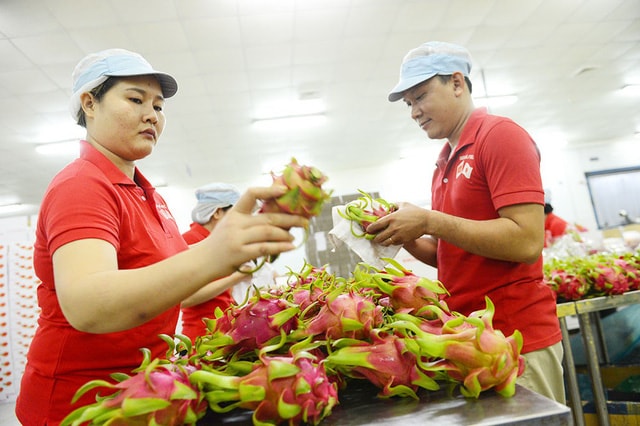Becoming a member of CPTPP: A golden opportunity for Vietnam
Many experts believe that the Government needs to amend and supplement appropriate mechanisms and policies so that Vietnamese enterprises can promote their strengths and increase their competitiveness.

Processing and packaging dragon fruit for export to Japan at Yasaka Fruit Processing Company Limited, Thuan An District, Binh Duong Province - Photo: TRUC PHUONG
Although affirming that Vietnam has many opportunities to promote economic development after becoming a member of the Comprehensive and Progressive Agreement for Trans-Pacific Partnership (CPTPP), many experts believe that the Government needs to amend and supplement appropriate mechanisms and policies for businesses to promote their strengths and increase their competitiveness.
At the same time, businesses themselves need to proactively change and seize opportunities from CPTPP instead of waiting for... fruit to fall into their laps.
* GrandfatherNguyen Hoang Dung(research director)and develop the Institute for Research on Leadership and Business Administration):

Photo: TR.M.
Must have strategytake advantage
Although the US withdrew from the TPP, this is still the highest quality agreement that Vietnam has ever participated in and is an opportunity.Golden opportunity for Vietnam to develop in the coming decade.
Because joining CPTPP will help Vietnam increase GDP through attracting investment and trade with CPTPP member countries; accelerate export development, especially with products that Vietnam has strengths in such as agricultural products, food, textiles... to intra-bloc countries; develop high-quality human resources as well as unskilled labor through labor exchange and export... By participating more deeply in value chains through cooperation and association with businesses in the CPTPP bloc, Vietnamese brands also have the opportunity to improve and reach further.
However, to turn opportunities into reality, we must have a strategy to take advantage of Vietnam's advantages in relation to CPTPP countries. For example, we must establish a specialized research team on which industries Vietnam needs to improve, promote investment attraction, and support businesses to participate. On that basis, propose specific policies and action programs for the state level, industry associations and businesses to take advantage of opportunities.
* GrandmaPhan Thi Thanh Xuan(Secretary General of the Association)VN leather shoes and handbags):

Photo: TVN
No rivalscompetein the block
Among CPTPP member countries, only Malaysia has the structure of leather and footwear production and export industry like
Vietnam but Malaysia is not Vietnam's main competitor for export orders to CPTPP member countries.
Therefore, the opportunity for Vietnamese footwear and leather exporting enterprises to increase their proportion and increase their opportunities to export to Chile, Australia, New Zealand, Mexico, Canada... is quite large once CPTPP officially takes effect. For example, Canada immediately applies 0% import tax on both footwear and handbags without a roadmap, which is an excellent opportunity for Vietnamese enterprises to further access this market.
For Japan, one of the key markets for Vietnam's footwear and handbag export industry with an average growth rate of 20-35% per year, if businesses know how to take advantage of the positive provisions of CPTPP, the industry's growth rate will be even higher than present.
* GrandfatherPham Van Son(Technical Director of Duc Hanh BMG Group):

Photo: N.AN
Need a transparent and fair playground
The agricultural sector is considered to be under the greatest competitive pressure in the CPTPP. Pork and chicken products will face difficulties.
Difficulty, because 100% of raw materials must be imported from other countries, higher costs due to transportation, poor technical conditions, lower productivity, so it is difficult to compete. In addition, the situation of one egg carrying 13 types of taxes, many other agricultural products also bear many unreasonable business conditions.
Meanwhile, countries in the region such as Thailand and Indonesia have exploited the potential of the Vietnamese market very well, taking advantage of Vietnam's cheap resources to produce, build a system of livestock processing, factories and sell products in the domestic market. Therefore, in order for domestic enterprises in the agricultural sector to survive and compete, the Government needs to have a mechanism to promote the development of the industry, create openness, equal mechanisms for enterprises, support policies on taxes, land, credit... to attract investment in agriculture. Enterprises do not need subsidies but need a fair and transparent playing field to operate more effectively.
GrandfatherLuu Duy Dan(Chairman of Vietnam Craft Villages Association):
There needs to be a policy worthy of craft villages.
Many products of Vietnamese craft villages and handicrafts have been exported to the US, Japan and many other demanding markets. The products have been standardized and gradually meet the requirements of other countries. However, many businesses admit that more than 80% of the designs of these products are made to order from abroad, there are not many original designs and they are too old. Not to mention, this industry has no planning for raw material areas, the labor force is limited, and the planning of raw materials does not meet the development needs...
The country has 5,411 craft villages, creating jobs for 11 million workers, of which 37% are regular workers, but there is no adequate and appropriate policy. Therefore, in my opinion, the Government should soon issue a decree on rural occupations, linked to planning of raw material areas, focusing on vocational training to improve production capacity and increase the application of technology, design models...

